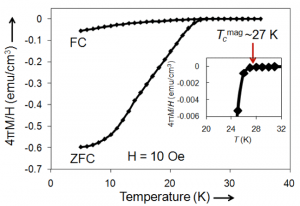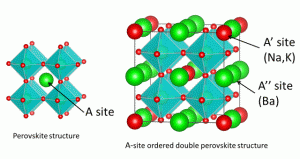PRESS RELEASE Discovery of New Superconducting Double Preovskite Oxide
Topics
- A new superconducting double perovskite bismuth oxide, (Na0.25K0.45)(Ba1.00)3(Bi1.00)4O12 , was discovered.
- This is the first example of an A-site ordered double perovskite structure with superconductive properties.
- This discovery provides a guiding principle for the exploration of new high-temperature superconductors, and an increased understanding of the mechanisms of superconductivity.
Overview
Research groups lead by Profs. Kumada and Tanaka (University of Yamanashi), Prof. Kuroiwa (Hiroshima University), Prof. Azuma (Tokyo Institute of Technology), and Prof. A.K.M.A. Islam (Rajshahi University, Bangladesh) discovered a new superconductive bismuth oxide, (Na0.25K0.45)(Ba1.00)3(Bi1.00)4O12. The structure of this material is an A-site ordered double perovskite, in which barium, sodium, and potassium occupy sites in an ordered way. This finding provides a guiding principle for exploring new high-temperature superconductors and understanding the mechanisms of superconductivity.
The achievements of this research were published online in the German scientific journal Angewandte Chemie International Edition on 26 February 2014.
Background
Although the superconductor is an important functional material for maglev propulsion systems and MRI techniques, it requires a considerable amount of energy for cooling, which is essential for the occurrence of the superconductivity phenomenon. Many types of superconductive materials have been developed to overcome the cooling requirement, including Cu-based, Bi-based, and Fe-based superconductors. Moreover, the superconductive mechanism in high-temperature superconductive materials is an important but unsolved scientific problem.
Research Particulars and Result
This new bismuth oxide material was synthesized via a hydrothermal method, which has been used for the syntheses of quartz, nanoparticles, and ceramics. The material formed a perovskite-type structure consisting of sodium, potassium, barium, bismuth, and oxygen, and its superconducting transition was confirmed at 27 K. Zero resistivity was confirmed in the pressed pellet form. Electron diffraction and synchrotron X-ray diffraction analyses revealed that the material did not have a commonly reported simple perovskite structure, but it exhibited an A-site ordered double perovskite structure with a longer range ordering. In this structure, the A site in ABO3 perovskite oxide splits into two A sites, which K/Na and Ba respectively occupy. Recently, A-site ordered double perovskite structures have attracted much attention for their potential applications as various functional materials for magnetoresistance and negative thermal expansion, and our research represents the first example of a double perovskite oxide with superconductive properties. The other advantages of this material are that the material can be synthesized at lower temperatures, and it consists of less toxic elements.
Future Prospect:
Although the superconducting transition temperature of this material is still relatively low, we expect that adjustments in the structure and composition will result in an increase in the transition temperature. This finding also allows us to further explore the relationship between superconductivity and long-range ordering, and provides a new guideline for exploring high-temperature superconductors.
Note:
This research was performed by following collaborators: Mirza H. K. Rubel, Akira Miura, Takahiro Takei, M. Mozahar Ali, Masanori Nagao, Satoshi Watauchi (Yamanshi University), Kengo Oka (Tokyo Institute of Technology), Eisuke Magome, Chikako Moriyoshi (Hiroshima University).
“Superconducting double perovskite bismuth oxide (Na0.25K0.45)(Ba1.00)3(Bi1.00)4O12 prepared by a low-temperature hydrothermal reaction”
Mirza H. K. Rubel, Akira Miura, Takahiro Takei, Nobuhiro Kumada, M. Mozahar Ali, Masanori Nagao, Satoshi Watauchi, Isao Tanaka, Kengo Oka, Masaki Azuma, Eisuke Magome, Chikako Moriyoshi, Yoshihiro Kuroiwa, A. K. M. Azharul Islam
Angewandte Chemie International Edition, Published Online 26 February 2014.

Fig.1 Magnetization curve of the new double perovskite bismuth oxide superconductor having a transition temperature of 27 K.
Fig. 2 Crystallographic scheme of simple perovskite and A-site ordered double perovskite structures. While simple perovskite structures have one type of A site in the ABO3 structure, an A-site ordered double perovskite structure has two types of A sites (A’ and A’’), which provide twice the ordering range. In the newly synthesized superconductor, Na/K and Ba occupy the A’ and A’’ sites, respectively.



















